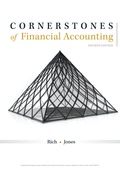
Concept introduction:
Liabilities:
Current Ratio is measure of the company’s ability to pay off its current liabilities using its current assets. It is calculated by dividing the total current assets by total current liabilities. The formula of the current ratio is as follows:
Acid test ratio:
Acid test ration is also called Quick ratio. This ratio is calculated by dividing the quick assets (Cash, Cash equivalents, Short term investments and current receivables) by total current liabilities for the year. The formula for Acid test ratio is as follows:
Cash ratio:
Cash ratio is calculated by dividing and cash and cash equivalents by the total current liabilities. The formula for Cash ratio is as follows:
Cash Ratio = Cash and cash equivalents/ Current liabilities
To indicate:
The situation in which current, quick and cash ratios are the most appropriate measures of the liquidity.
Want to see the full answer?
Check out a sample textbook solution
Chapter 8 Solutions
Cornerstones of Financial Accounting
- Charlotte's Cleaning Services began the year with total liabilities of $120,000 and stockholders' equity of $55,000. During the year, the company earned $140,000 in net income and paid $10,000 in dividends. Total liabilities at the end of the year were $260,000. How much are total assets at the end of the year? Provide answerarrow_forwardSunflower Oil Processors incurred the following plant maintenance costs: 65,000 units processed with maintenance costs of $92,000 48,000 units processed with maintenance costs of $75,000 What is the variable cost per unit processed?arrow_forwardAnswerarrow_forward
- Please provide answer the following requirements a and b on these financial accounting questionarrow_forwardCharlotte's Cleaning Services began the year with total liabilities of $120,000 and stockholders' equity of $55,000. During the year, the company earned $140,000 in net income and paid $10,000 in dividends. Total liabilities at the end of the year were $260,000. How much are total assets at the end of the year?arrow_forwardProForm acquired 70 percent of ClipRite on June 30, 2023, for $1,470,000 in cash. Based on ClipRite's acquisition-date fair value, an unrecorded intangible of $760,000 was recognized and is being amortized at the rate of $19,000 per year. No goodwill was recognized in the acquisition. The noncontrolling interest fair value was assessed at $630,000 at the acquisition date. The 2024 financial statements are as follows: Items Sales Cost of goods sold Operating expenses Dividend income Net income Retained earnings, 1/1/24 Net income Dividends declared Retained earnings, 12/31/24 Cash and receivables Inventory Investment in ClipRite Fixed assets Accumulated depreciation Totals Liabilities Common stock Retained earnings, 12/31/24 Totals Note: Parentheses indicate a credit balance. ProForm $ (1,030,000) 650,000 330,000 (56,000) $ (106,000) $ (3,800,000) (106,000) 330,000 $ (3,576,000) $ 630,000 520,000 1,470,000 2,200,000 (400,000) $ 4,420,000 $ (544,000) (300,000) (3,576,000) $ (4,420,000)…arrow_forward
 Cornerstones of Financial AccountingAccountingISBN:9781337690881Author:Jay Rich, Jeff JonesPublisher:Cengage Learning
Cornerstones of Financial AccountingAccountingISBN:9781337690881Author:Jay Rich, Jeff JonesPublisher:Cengage Learning Intermediate Accounting: Reporting And AnalysisAccountingISBN:9781337788281Author:James M. Wahlen, Jefferson P. Jones, Donald PagachPublisher:Cengage Learning
Intermediate Accounting: Reporting And AnalysisAccountingISBN:9781337788281Author:James M. Wahlen, Jefferson P. Jones, Donald PagachPublisher:Cengage Learning College Accounting, Chapters 1-27AccountingISBN:9781337794756Author:HEINTZ, James A.Publisher:Cengage Learning,
College Accounting, Chapters 1-27AccountingISBN:9781337794756Author:HEINTZ, James A.Publisher:Cengage Learning,- Century 21 Accounting Multicolumn JournalAccountingISBN:9781337679503Author:GilbertsonPublisher:Cengage
 Managerial AccountingAccountingISBN:9781337912020Author:Carl Warren, Ph.d. Cma William B. TaylerPublisher:South-Western College Pub
Managerial AccountingAccountingISBN:9781337912020Author:Carl Warren, Ph.d. Cma William B. TaylerPublisher:South-Western College Pub





